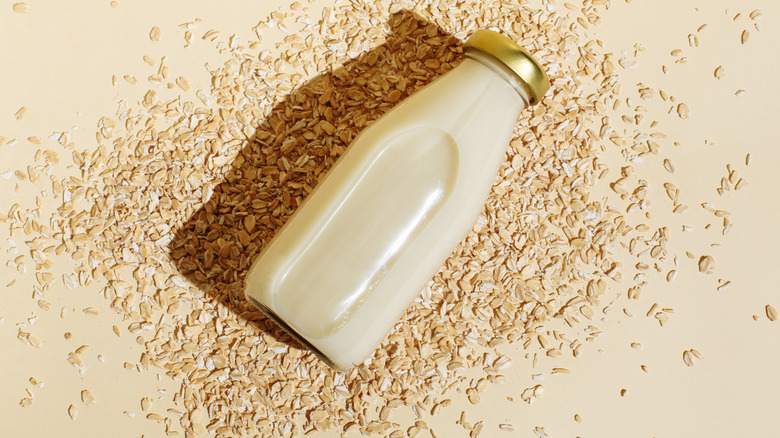Why You May Want To Think Twice Before Making Oat Milk At Home
Oat milk is trending and not just with vegans. You can't even walk into Dunkin Donuts these days without overhearing someone order an oat coffee. It's everywhere. So you're probably tempted to jump on the DIY bandwagon, thinking homemade oat milk will be a cheaper, healthier way to indulge. It sounds simple — blend oats and water, strain, and voilà! You've got oat milk. But, like many DIY projects, the reality isn't always as smooth.
One of the biggest hurdles reported with homemade oat milk is the texture. Unlike store-bought versions, homemade often has a much grittier feel. Even with the best blender (and you need a good blender) achieving total silkiness is tough. This isn't a massive issue if you're mixing it into something else like a smoothie, but if you're downing a glass with some cookies, that powdery sensation might disappoint you.
For their super smooth and long-lasting results, it's good to know that commercial oat milk makers have some serious equipment on their side — and specific ingredients that help consistency, like enzymes that break down the oats' starch. They use high-pressure homogenization, which breaks down the oat particles to create that perfectly smooth, creamy texture. This process also helps keep the oat milk from separating and maintains its consistency for a longer shelf life. And while we know you won't have access to industrial-grade equipment at home, understanding how the pros do it can help set your expectations, and give you a better idea of what's achievable in your own kitchen.
Tips for better homemade oat milk
If you want to make your oat milk a little smoother, here are some tips. Try experimenting with the soaking time — 10 to 30 minutes max. Soaking oats before blending helps soften them, but if you soak them for too long, you might end up with a slimy, jelly-like texture, similar to that of a flax egg, one of many excellent egg substitutes. Shortening the soak time could help reduce this issue. And adding a pinch of salt or a splash of maple syrup can also help balance out any weird flavors that may pop up.
Still not satisfied? There are other non-dairy milk alternatives you can make at home such as almond milk, a simple option that only requires almonds and water (plus some spices and sweetener, if you like). Cashew milk is another good one, as blended cashews are known for their creamy texture and low graininess — which is why they're used so often in creamy dairy-free recipes like vegan queso.
And homemade oat milk can be a bit of a drama queen, separating easily because it doesn't have emulsifiers. After a day in the fridge, the liquid and solids will naturally part ways, requiring a good shake. Not a huge deal, but it's annoying if you're used to pre-packaged convenience. A simple fix? Add lecithin or Xanthan gum for creamier, more stable oat milk. But suddenly, it's no longer just oats and water — and isn't that the appeal?


